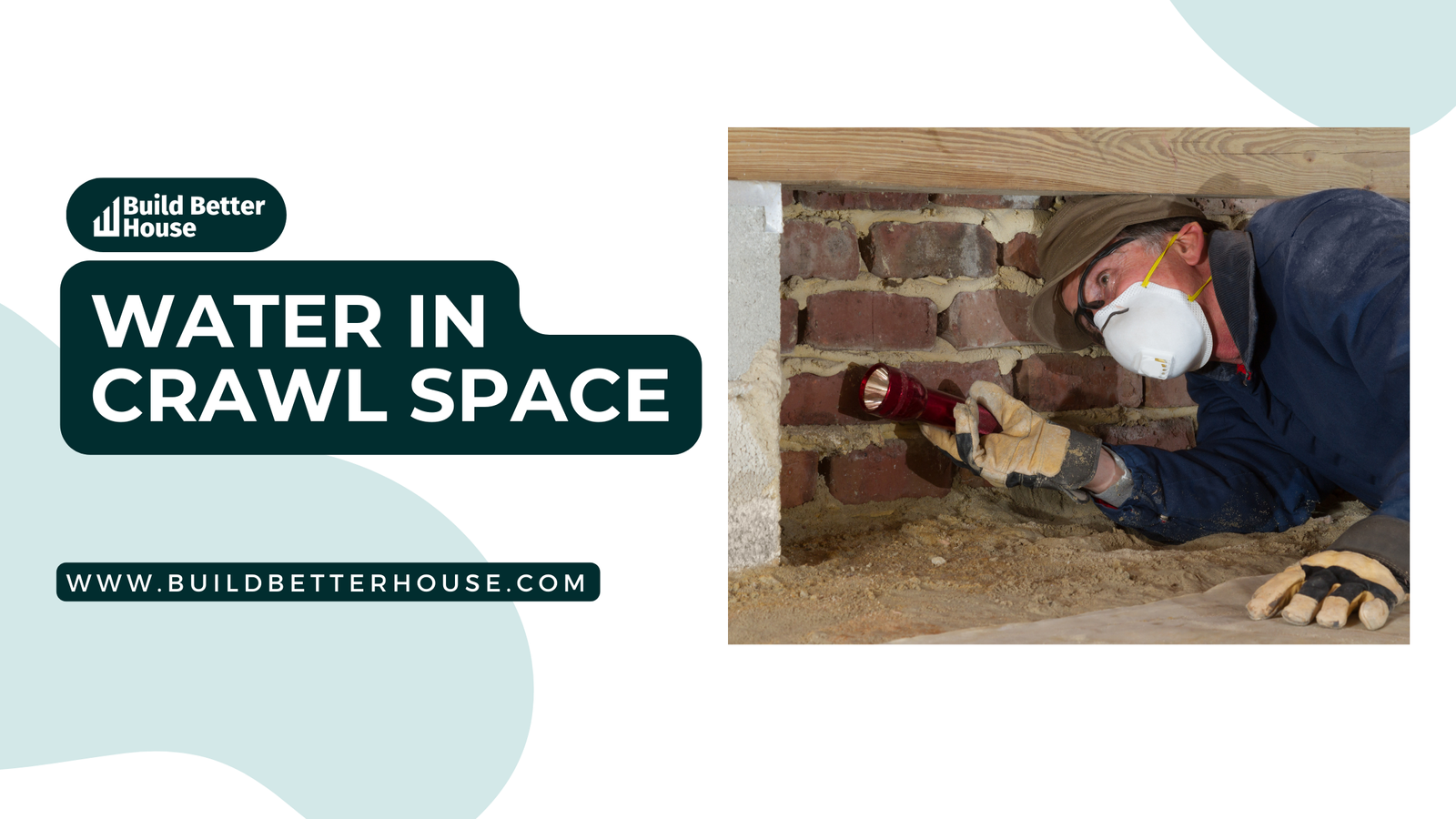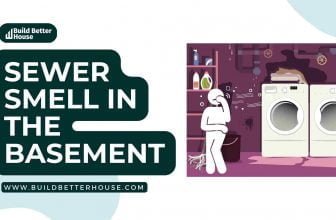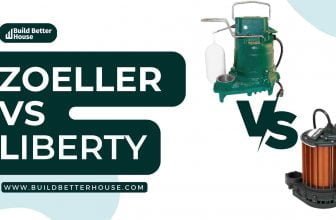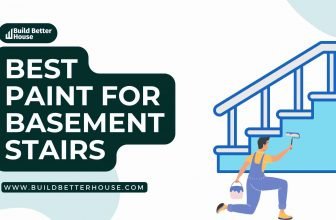Water in Crawl Space: Here’s How To Fix [2023]

Water in crawl spaces is a common issue that many homeowners face, and it’s essential to address this problem before it leads to significant damage. A crawl space is an area beneath your house that provides access to plumbing, electrical, and other utility systems. While it’s not a living space, having water in your crawl space can still cause several issues that negatively impact your home’s structural integrity and overall health.
There are various causes of water accumulation in a crawl space, including plumbing leaks, seepage from surrounding soil, and condensation. Heavy rain can exacerbate the problem, leading to standing water that may not drain for months or even years. This prolonged exposure to moisture can cause damage to your home’s foundation, rot wooden beams and joists, and promote mold growth.
Addressing water in your crawl space is crucial. Identifying the source of the water, taking preventive measures, and removing excess moisture are all necessary steps to protect your home. Whether you choose to tackle the problem yourself or enlist professional help, ensuring a dry, well-maintained crawl space is essential for the overall health and safety of your home.

Key Takeaways
- Identifying the cause of water in your crawl space is crucial for effective remediation
- Addressing moisture issues can prevent long-term damage to your home’s structure and reduce health risks
- Proper prevention measures and maintenance are essential for keeping your crawl space dry and safe.
Causes of Water in Crawl Space
There are several reasons why water may accumulate in your crawl space. Identifying the source of the problem is essential for proper remediation. Here are some common causes:
Plumbing Leaks: Your crawl space may have plumbing pipes running through it, and any leaks can lead to water accumulating in this area. Regularly inspect your plumbing system for any signs of leaks or damage to prevent water buildup.
Surface Water: Keep a lookout for surface water issues such as poor grading around your home’s foundation. If the ground isn’t graded correctly, water may flow towards your house and seep into your crawl space. To remedy this, ensure the ground slopes away from your home, promoting proper drainage.
Groundwater: If the water table is high in your area, groundwater may seep into your crawl space, creating a damp environment. In such cases, consider installing a sump pump to remove excess water and help maintain a dry crawl space.
Rainwater: Heavy rainfall can lead to water infiltration into your crawl space, especially if the surrounding soil is saturated with water. Prevent this by installing a rain gutter system that efficiently directs rainwater away from your home’s foundation.
Gutters: Gutters play a critical role in preventing water damage to your home. Make sure your gutters are clean and free from debris that may cause clogs or overflow. Overflowing gutters can result in water pooling near your foundation and seeping into your crawl space.
Taking steps to address these common causes ensures your crawl space stays dry and helps prevent structural damage and other related issues.
Problems Associated with Water in Crawl Space
Having water in your crawl space can lead to various issues that can negatively affect your home and health. One of the primary concerns is the growth of mold and mildew, which thrive in damp environments. Excess moisture can promote the growth of mold spores, which can then compromise the indoor air quality and may cause allergy-like symptoms.
Additionally, the presence of moisture in the crawl space can lead to wood rot and the weakening of the structural integrity of your home. When wood comes into contact with water, it is susceptible to fungal decay. This can compromise the stability and safety of your home.
Pests such as ants, termites, and rats can also be attracted to damp crawl spaces. These organisms are drawn to the moisture and can cause further damage to the structure of your home, as well as create unsanitary conditions. It is important to address water issues promptly to prevent these infestations.
High humidity is another concern associated with wet crawl spaces. The persistent dampness can lead to increased levels of moisture throughout your home, which in turn can result in higher energy bills, as your HVAC system works harder to regulate humidity levels. This energy loss is not only costly but could also impact your home’s overall energy efficiency.
Moreover, water damage from pooling or seeping into the crawl space can lead to long-term issues if left untreated. This includes potential damage to insulation and electrical systems, and even a negative impact on your home’s resale value.
In summary, it is crucial to address water problems in your crawl space promptly to prevent a variety of issues related to mold, wood rot, pests, humidity, and structural damage.
Identifying Water in Crawl Space
When you suspect that there might be water in your crawl space, it’s essential to identify the presence of water and its source. To help you with this process, look out for the following signs:
- Standing water: One of the most apparent indicators of water in a crawl space is the presence of standing water or puddles on the ground. This can be a result of leaks, heavy rainfall, or improper grading.
- Visual signs: Inspect the area for any visible signs of water damage, such as discoloration, stains, or wood rot. Check the foundation walls, support beams, and floor joists for any damage.
- Smell: If you notice a musty or damp odor around your crawl space, this could be an indication of water or moisture issues. This smell usually arises from the presence of mold or mildew due to prolonged exposure to moisture.
- Humidity issues: High levels of humidity can cause condensation in your crawl space, which can lead to water accumulation. Invest in a hygrometer to measure the humidity levels, and if it’s above 60%, it’s time to address the moisture issues.
- Mold and mildew: In a damp environment, mold and mildew thrive on organic materials like wood and paper, causing damage to your crawl space and potentially affecting your home’s air quality. Inspect for mold growth on surfaces and materials within the crawl space.
By looking for these signs and identifying the presence of water in your crawl space, you can take the necessary steps to address the issue and protect your home from further damage.
Prevention Measures
Proper prevention measures can help you avoid water accumulation in your crawl space. By following these steps, you can maintain a dry and healthy environment under your home.
Firstly, ensure that the grading around your house slopes away from the foundation. This will direct water away from the crawl space and prevent pooling. Regularly inspect the area for any signs of settling or erosion, and make necessary adjustments to maintain proper grading.
Next, prioritize gutter maintenance by cleaning your gutters and removing debris at least twice a year. This prevents blockages and allows water to flow freely through the gutter system. In addition, check that your downspouts are directing water at least 5-6 feet away from your home’s foundation, preventing water from entering the crawl space.
Installing a vapor barrier on the floor of your crawl space is another essential prevention measure. A vapor barrier is a plastic or foil sheet that covers the ground and slows down moisture migration from the soil into the crawl space. Make sure it’s properly installed, with no gaps or tears, to achieve maximum effectiveness.
Be proactive in identifying and fixing any leaks that could lead to water in your crawl space. Inspect your plumbing, HVAC system, and other potential sources of water infiltration, and address any issues immediately to minimize damage.
Waterproofing your crawl space involves sealing the space against moisture and water intrusion. This approach includes both interior and exterior waterproofing. While interior waterproofing focuses on eliminating accumulated water, exterior waterproofing aims to prevent water from seeping into the area.
Consider crawl space encapsulation as a comprehensive prevention measure. This process involves sealing the entire crawl space with a vapor barrier, covering walls, and floors, and often includes the installation of a dehumidifier to keep humidity levels in check.
Finally, maintain proper ventilation in your crawl space to prevent moisture buildup. Assess your ventilation system, making sure vents are clean, functional, and correctly positioned. Remember, a well-ventilated crawl space is crucial to keeping moisture levels under control and preventing water-related issues.
By implementing these prevention measures, you can effectively safeguard your crawl space against water intrusion and protect the structural integrity of your home.
Removal and Remediation
When faced with water in your crawl space, it’s important to remove the excess moisture and remediate any damage. One effective solution is installing a sump pump, which helps to transfer water from the crawl space to an exterior location. This ensures continuous drainage, safeguarding your home from potential problems caused by stagnant water.
In addition to a sump pump, you might consider using a dehumidifier to reduce the humidity levels in the crawl space. This device extracts moisture from the air, maintaining a dry and healthier environment. If circulation is an issue, fans can be strategically placed to improve air movement and accelerate the drying process.
Another crucial aspect of water removal in crawl spaces is ensuring proper drainage. One way to achieve this is by installing a French drain system around the foundation of your home. These drains are designed to re-route water away from your house, preventing it from seeping into the crawl space.
While some of these tasks can be done yourself, it’s often best to consult with a professional contractor who specializes in water remediation and restoration. They possess the necessary skills, equipment, and expertise to address moisture issues effectively and efficiently. In some cases, they might recommend a SmartSump system that is specifically designed for crawl spaces and can provide reliable long-term protection against water intrusion.
Regardless of which method you choose for moisture removal, it’s crucial to have a humidity control plan in place. Regularly monitoring the humidity levels in your crawl space will help you maintain a balanced environment and avoid future issues.
Lastly, it’s wise to invest in a battery backup pump for your sump pump system. In the event of a power outage or pump failure, the backup pump will activate and continue to protect your home by managing water levels. This added layer of protection is crucial during severe weather conditions or unexpected equipment malfunctions.
By addressing the moisture issues within your crawl space through removal and remediation, you’ll be better equipped to protect your home and maintain a healthy living environment.
Crawl Space Inspection and Evaluation
Before addressing water issues in your crawl space, it’s essential to conduct a thorough inspection and evaluation. Hiring a professional contractor or a crawl space evaluation expert is recommended, as they will be familiar with potential pitfalls and the safest procedures.
You should first inspect visible spots, such as electrical outlets, vents, and other openings that could allow water to enter your crawl space. Also, check for signs of water damage, mold, and mildew along the walls, floor, and surfaces, as these can be indications of ongoing moisture problems.
Next, evaluate your basement systems, including your sump pump, drainage system, and waterproofing measures in place. If any of these components are absent or malfunctioning, it might lead to standing water, excessive moisture, or musty odors. Pay close attention to the foundation walls, as cracks or gaps here can allow water to seep into your crawl space.
A crawl space inspection should also include checking plumbing lines, gutters, and downspouts to determine if these are also contributing to water infiltration. Additionally, assess whether there’s proper grading around the exterior of your home, as improper grading can lead to water pooling near your foundation and eventually entering your crawl space.
After gathering insights from your inspection and evaluating the severity of the problem, you may need to consult with crawl space professionals, such as Basement Systems or Crawl Pros, to help you determine the best course of action to effectively deal with water in your crawl space.
DIY vs Professional Services
When dealing with water in your crawl space, you may be considering whether to take the DIY route or hire a professional service. Understanding the differences in cost, time, difficulty, techniques, and tools can help you make an informed decision.
In terms of cost, DIY solutions can save you money initially, but you may end up paying more in the long run if the issue isn’t resolved correctly. Waterproofing a crawl space can cost between $3,000 and $15,000 when done professionally, but these costs can be higher if additional repairs are needed 1. When attempting DIY repairs, you might need to invest in tools like a wet/dry shop vac, insulation materials, nails, and pipes.
Time is another important factor to consider. A DIY landscape repair project can take longer to complete if you don’t have the necessary experience. Professionals, on the other hand, should be able to efficiently manage time and resources to complete the job.
Difficulty level is another aspect you need to think about. While some DIY repair techniques might seem straightforward, there are potential risks involved. A professional service will have experts who are trained to tackle even the most complex situations. They’ll be able to use more advanced tools and techniques to address the root cause of the water in the crawl space.
Addressing insulation is often an essential part of repairing a crawl space. If you’re not familiar with the proper methods, you may end up choosing the wrong insulation materials or installing them incorrectly. A professional service will have the expertise to help you select the correct insulation materials and ensure that they’re installed properly.
Finally, consider the tools and techniques utilized in repairing a crawl space. You may not have access to all the necessary equipment for a DIY repair, and you may have to spend additional money on tools that you might not use again. A professional service will be equipped with all the appropriate tools to perform the job effectively.
In conclusion, when dealing with water in your crawl space, it’s crucial to weigh the pros and cons of DIY vs professional services. Keep in mind the factors discussed above—cost, time, difficulty level, techniques, and tools—so that you can make the best decision for your situation.
Regional Considerations
When dealing with water in your crawl space, it’s essential to consider the regional factors that can contribute to the issue. Weather and climate play a significant role in the likelihood of water accumulation in your crawl space, especially in areas with heavy rainfall, high humidity, or frequent flooding.
In the Pacific Northwest, for example, the region is known for its wet climate and consistent rainfall. This makes homes in areas like Oregon particularly susceptible to water-related issues in their crawl spaces. Even the landscape and soil composition can contribute to the problem, as some regions have soil types that retain more moisture than others.
Addressing water in your crawl space in such regions requires you to be diligent in maintaining your home’s drainage systems and implementing additional measures to prevent moisture accumulation. In the Pacific Northwest or similar regions, you should:
- Ensure your gutters are clean and downspouts are properly directing water away from your home’s foundation.
- Install French drains or other drainage systems to reduce surface water runoff near your house.
- Inspect and seal any cracks or gaps in your foundation that may be allowing water to seep in.
- Use a vapor barrier in your crawl space to reduce the amount of moisture that can come into contact with the dirt floor and crawl space structure.
- Consider installing a sump pump if your crawl space is prone to standing water to help remove water quickly.
By being proactive and taking these steps, you can reduce the chances of water accumulating in your crawl space and causing damage to your home’s structure. Remember, however, that each region has its unique conditions, and it is essential to adapt these prevention measures to the specific needs of your area.
Conclusion
Water in your crawl space is a serious issue that requires timely attention. Ignoring this problem can lead to higher energy bills, mold growth, and damage to the structural integrity of your home. Understanding the causes of water accumulation in your crawl space and implementing appropriate solutions are crucial.
Remember, damp air takes more energy to heat or cool, resulting in increased energy costs. Mold thrives in moist environments, and it can cause severe health problems if left unaddressed. Additionally, prolonged exposure to moisture can weaken wooden structures and jeopardize the stability of your home.
To resolve the issue, it’s essential to first identify the cause of water in the crawl space. Common culprits include clogged drains, leaky pipes, and improper landscaping. While some of these problems can be fixed by a handy homeowner, others may require professional intervention.
Once the cause is determined, take appropriate action to fix the issue. Incorporate techniques to keep the crawl space dry and maintain acceptable levels of humidity to prevent mold growth and keep energy bills in check.
By addressing the water problem in your crawl space, you will not only protect your home but also ensure a healthier and more energy-efficient living environment for you and your family.
Frequently Asked Questions
What causes water to accumulate in a crawl space?
Water can accumulate in your crawl space from various sources such as active leaks from pipes or plumbing fixtures, improper drainage from gutters and downspouts, or a high water table. Groundwater seepage and heavy rainfall can also contribute to water buildup.
How can I effectively remove water from my crawl space?
To effectively remove water from your crawl space, you can use a sump pump to extract standing water. Additionally, you should repair any leaks and improve your home’s drainage system to prevent future water buildup. Invest in proper crawl space insulation and consider installing a vapor barrier to reduce moisture.
What are the signs of water issues in a crawl space?
Signs of water issues in a crawl space may include musty odors, higher energy bills due to damp air, mold growth, or wood rot. You might also notice water stains or dampness on the walls and floors, or standing water in the crawl space itself.
How can I prevent water in a crawl space due to a high water table?
To prevent water in your crawl space due to a high water table, you should install a sump pump and a drainage system designed for high water tables. Properly grading the soil around your home’s foundation can also help direct water away from the crawl space. Waterproofing the walls and installing a vapor barrier can minimize moisture infiltration.
How to fix a water leak in a crawl space?
Fix a water leak in your crawl space by first locating the source of the leak, which could be pipes, plumbing fixtures, or foundation cracks. If it’s a pipe or fixture leak, repair or replace the damaged components. For foundation leaks, seal the cracks with hydraulic cement or other waterproof sealant. Ensure proper drainage around your home to reduce water seepage.
Is it normal for a small amount of water to be present in a crawl space?
A small amount of water may occasionally be present in your crawl space due to condensation or minor leaks. However, any persistent moisture can lead to mold growth and structural damage. It’s essential to address the issue by improving ventilation, installing a vapor barrier, and addressing any leaks or drainage problems.

![Water in Crawl Space: Here’s How To Fix [2023]](https://buildbetterhouse.com/wp-content/uploads/thumbs_dir/5-1-q0c5opcu48m0gryxyerlz33avflda51mfk3yrkoenw.jpg)
![Water in Crawl Space: Here’s How To Fix [2023]](https://buildbetterhouse.com/wp-content/uploads/thumbs_dir/16-q0c6b0308r4vvrkxr1r04giy6hotvnke5x8mlvm724.jpg)



